The History of KJBS Radio
San Francisco, California
![]()
This typewritten history of San Francisco’s KJBS, produced for the station in the late 1930s, was provided in 1979 to the Bay Area Radio Digest by A. Judson (Judd) Sturtevant, the longtime President and General Manager of KFAX. KJBS, the predecessor of 50,000-watt KFAX, was one of the legendary stations of early broadcasting in the Bay Area. Established by the Julius Brunton and Sons Company of San Francisco — the local distributor of Willard Storage Batteries — the station’s history, as told here, reflects the colorful era of progress and growth in radio.
![]()
There is an oft-repeated expression that “good things come in small packages.” From the radio listener’s viewpoint, this can truly he applied to KJBS, one of San Francisco’s pioneer broadcasting stations.
STATION HAS COLORFUL HISTORY
Statistics and figures are often dry and boresome things, but those in connection with the steady growth and development of KJBS are interesting — for it is not imaginative to describe them as milestones on the road of radio broadcast advancement.
The history of this popular Pacific Coast station dates back to the early days of 1925 — January 3rd, to be exact. It was on that day that Julius Brunton and Sons Company crossed their first bridge in what was, at that time, a new field of commercial activity — Radio Broadcasting.
The call letters assigned to the station at its inception were KFUQ — and the little five-watt transmitter operated on a wavelength of 234 meters, using six-hundred volts of storage batteries for power. A slight revision of wavelength to 236 meters was effected on March 27, 1925, and the call letters were changed to KJBS, a combination derived from the initials of the company’s name — Julius Brunton and Sons.
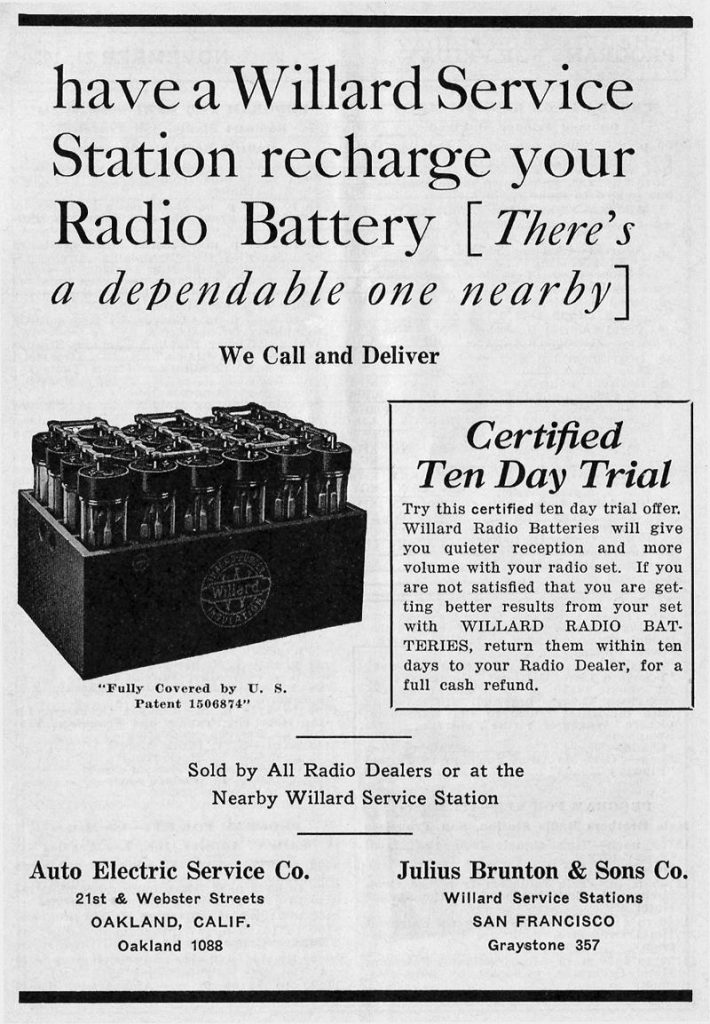
EARLY CHAOTIC CONDITIONS IN BROADCASTING
In those early days, chaotic conditions reigned in the broadcasting world. Stations were vying with each other for the most favorable reception spot on the listener’s dial. Wavelength changes were the rule, rather than the exception. As a result, KJBS found it necessary to apply for a change of wavelength in order to eliminate interference from KTAB [now KSFO], then operating on 240 meters. In consequence, October of 1925 found KJBS assigned the wavelength of 220 meters, or 1360 kilocycles.
An undesirable condition of broadcasting in the pioneer days was the intermittent operation of the few existing stations. After one or two hours, these stations would sign off, leaving the listeners’ receivers void of entertainment until the next scheduled broadcasting period. KJBS was quick to conceive the need of continuous radio entertainment — there should be no dead spots in the listener’s daily radio fare if broadcasting was to assume its rightful place as the greatest of entertainment media.
KJBS HAS SERVICE TO THE LISTENER IN MIND
With this thought in mind, the station formulated a policy of “filling in the gaps” — that is, being on the air when no other broadcasting service was available. The listening public was quick to grasp the value of this policy and as a result, the little station gained tremendous popularity. The operating schedule at that time was 9 to 11:30 and 2 to 4 p.m. on weekdays, and 5 to 6:30 on Sundays. There were also three evening periods each week from 8 to 11 o’clock.
These evening periods were discontinued in July 1926, owing to the fact that several new stations were assigned frequencies so close to KJBS as to make good reception of the station’s programs possible only to a minority audience in the vicinity of the transmitter.
STATION INCREASES POWER
In 1927, a decided step forward was achieved. KJBS increased its power to fifty watts and a new transmitter was installed. With this ten-fold power increase, it was decided that evening programs would once again be worthwhile, particularly in view of the fact that there was a decided lack of variety on the air at that time.
Therefore, on September 23, 1927, the station commenced an evening schedule of 9 to 10 p.m. two nights a week, and 8 to 11 three nights a week. The two “silent nights” were Saturday and Sunday. Also about this time, KJBS established a Sunday afternoon musical program from 2:30 to 4:30. This pioneer move was not taken up by other stations for many months afterward — an interesting point, in view of the fact that today Sunday is the most sought after broadcast time.
On December 18, 1927, KJBS further increased its Sunday schedule to 1:30 to 6 p.m. At this time the week-day broadcast hours were 9:30 to noon, and 1:30 to 5 p.m.
STATION MAKES ANOTHER MOVE FORWARD
On March 1, 1928, another progressive step was made when KJBS came on the air with one-hundred watts power. Two more wavelength changes also took place during that year. These were made at the station’s request, in an attempt to improve reception by eliminating interference from other radio stations and power-line disturbances. The general reallocation of wavelengths by the Government on November 11, 1928, gave KJBS its requested channel of 1100 kilocycles. On the same date, an operating schedule of continuous broadcasting from 7 a.m. to local sunset was inaugurated.
Another frequency change to 1150 kilocycles was found necessary in January 1929 in order to eliminate cross-talk from KTAB’s first harmonic. Then, on April 15th of that year, the station’s position on the dial was further improved by its assignment to 1070 kilocycles.
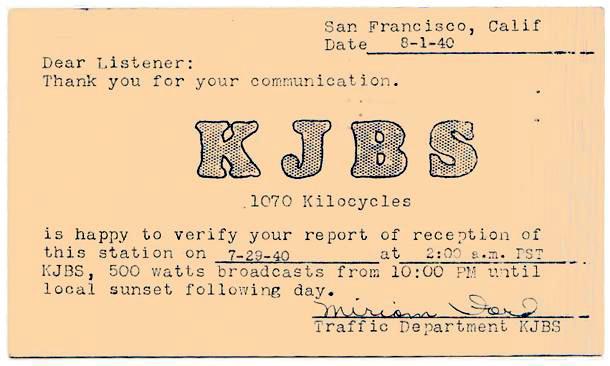
POPULARITY OF KJBS STEADILY INCREASES
Through all this period of change and stabilization in the radio broadcasting field, the growth of KJBS was steady and consistent, its popularity with listeners ever on the increase. As far back as 1925, this popularity was in marked evidence far and wide — and even with the station’s low power at that time, reports of reception were regularly received from Alaska, the Panama Canal Zone and points as far east as New York.
KJBS AIDS FIRE DEPARTMENT
In the development of radio communication, KJBS has to its credit several pioneer ventures. In April 1925 the station, in cooperation with the San Francisco Fire Department and Fire Chief Murphy, volunteered its services to conduct tests between a shore station and the city fire tugs. A five-watt transmitter using the call 6RY on the 180-meter wavelength was established as the shore station. A similar transmitter, operating on 150 meters aboard one of the tugs, successfully maintained a two-way conversation by radio-telephone. This test proved the practicability of radio communication in fighting waterfront fires. It was a prompt and positive means of issuing instructions from the Fire Department headquarters to the fire tugs as to the location of fires and other waterfront casualties.
PIONEER MOBILE SHORTWAVE BY KJBS
In July 1925, during the Diamond Jubilee celebrations, KJBS successfully accomplished what was probably the first instance of mobile shortwave radiophone transmission. A fifty-watt transmitter, operating on 61 meters, was installed in a truck, using the station’s experimental call 6XAR. This truck led the monster parade, successfully rebroadcasting through KJBS the various bands and noises of the crowd. Later, a detailed description of the various beautiful floats and other objects of interest was given from a location near the City Hall. The entire cost of this novel experiment was borne by the station.
During 1926, considerable experimental work was conducted by KJBS in the simultaneous broadcasting of that station’s programs over its shortwave transmitter 6XAR. A regular daily schedule was maintained and this activity was instrumental in large part toward increasing public interest in shortwave radio communication in the San Francisco Bay Area.
STATION ASSISTS IN MODERNIZING
POLICE DEPARTMENT
In December 1929, KJBS offered its services and facilities to the San Francisco Police Department as a means of proving the value of this modern method of communication in the prompt apprehension of criminals. The station equipped police cars with receiving sets which picked up the emergency calls broadcast by KJBS.
These calls took precedence over any program that might be on the air at the time, and, of course, provided the station’s listeners with many a real thrill. But of more importance, the system proved so efficient that the Police Department became convinced that radio communication was a necessity in tracking down criminals.
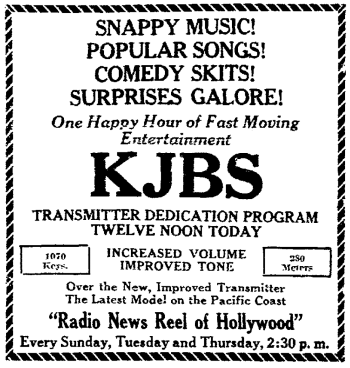
WESTERN ELECTRIC EQUIPMENT INSTALLED
Always keeping abreast of the times in every possible way, KJBS improved its services to listeners on February 9, 1930, by being the first Pacific Coast station to install Western Electric reproducing equipment, the most modern apparatus available at that time for the broadcasting of electrically recorded programs.
INAUGURATION OF OWL PROGRAM SERVICE
Then, on April 19, 1930, KJBS filled a long-felt need in Bay Region broadcasting by commencing an all-night service. Signing on at midnight, the station broadcast continuous programs until sunset — a daily average of more than eighteen hours! This was another “first” for KJBS — first in Northern California to bring the listener all-night entertainment. This Owl Program has been consistently maintained to the present time.
OFFICIAL BROADCAST STATION FOR
POLICE AND FIRE DEPARTMENTS
April 1930 also found KJBS in the capacity of official broadcasting station for the San Francisco Police Department, with all messages being preceded by the wail of a regulation siren.
The first week in May found the Fire Department also relying on this active broadcasting station to transmit to Fire Department officials emergency news and instructions in proceeding to fires. KJBS proved the value of this service and provided it to both departments for almost eighteen months at no cost to the city. It was discontinued only upon the installation of the city’s own shortwave transmitter.
POLO BROADCASTS
In the interest of providing its listeners with new and novel forms of radio programs, KJBS was the first Northern California station to bring to the ether lanes that King Of Sports, polo. Purely in the spirit of promoting public interest, the station bore the expense of installing remote-control equipment at the Marina Polo Field in the San Francisco Presidio; and many an exciting game was described by one of the Army captains. The public’s response to this broadcasting resulted in greatly increased attendance at the field, much to the gratification of the Army teams.
BROADCASTING FROM A SUBMARINE
In October 1931, KJBS was first to successfully accomplish the feat of rebroadcasting transmissions from a Navy submarine. This spectacular event took place in San Francisco Bay during the Navy Day Celebration held under the auspices of the Junior Chamber of Commerce. Once again KJBS demonstrated its steadfast policy in this complicated broadcast.
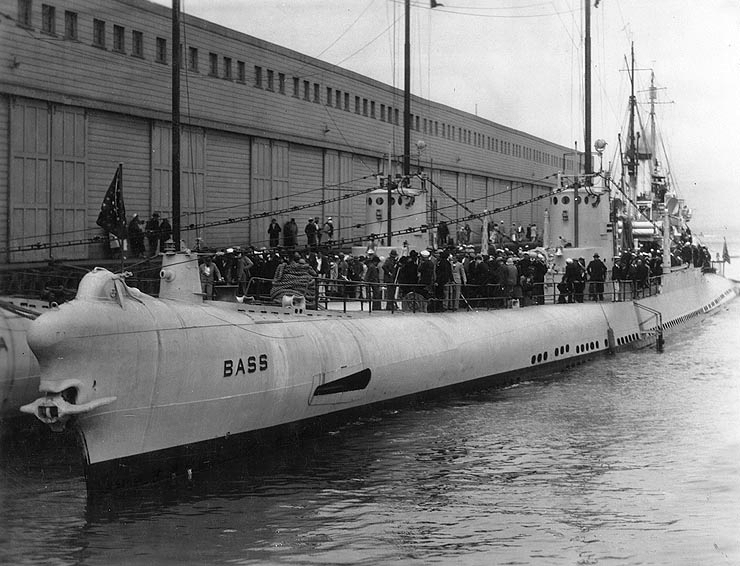
Special shortwave equipment was installed in the U.S. Navy Submarine Bass, also known as the V-2. An elaborately equipped receiving station was erected on the Marina shore, and this was connected by land lines to the KJBS transmitter.
Many civic dignitaries and distinguished guests were aboard the submarine, and listeners were given the thrill of hearing these personages talking from the control room of the underseas fighter. All the characteristic sounds of a submarine under way were carried to the thousands of receiving sets that tuned in on this novel broadcast.
CIVIC EVENTS BROADCAST BY KJBS
Closely connected with the Navy Day Celebration is the San Francisco Annual Harbor Day. Associated with it each year is a pre-Harbor Day luncheon, held on board one of the steamships of the various lines utilizing the Port of San Francisco.
For several years, KJBS has been asked by the Junior Chamber of Commerce to bring to listeners the entire proceedings of this colorful occasion. In 1931, the event took place aboard the Liberia Liner California. The Grace Liner Santa Elisa provided the setting in 1932, and in 1933 the luncheon was held in July aboard the palatial Matson Liner Mariposa while in her San Francisco berth. KJBS handled all these broadcasts by remote control, the equipment being taken aboard ship and connected by land lines to the main studios.
This was accomplished by means of special shortwave transmitting equipment installed in a power boat which met Old Ironsides as she entered the harbor. The colorful proceedings described over this shortwave installation, which had call letters KIFT, were received by specially designed shortwave sets located on Telegraph Hill, one of San Francisco’s highest points of vantage.
From there the broadcast was relayed by land lines to the studios of KJBS, from whose transmitter it reached the listeners. Microphones were also installed at the Telegraph Hill receiving station, from where a magnificent view of the entire harbor is obtainable, thus enabling the announcers there to cooperate with those on the boat in giving a very complete and vivid account of the historic old vessel’s arrival.
Many technical problems had to be solved by KJBS engineers in setting up the equipment required for this unusual broadcast. The crystal-controlled shortwave transmitter aboard the power boat was specially designed and built for the occasion by the station staff.
The entire broadcast of one-and-one-half hours duration was heard perfectly by many thousands, and KJBS received much favorable commendation as the result of its public-spirited efforts in arranging such an interesting portrayal of a rare and colorful occasion.
NAVY DAY ULTRA-HIGH FREQUENCY BROADCAST
Ultra-high frequency experiments by the station technical staff bore fruit first during San Francisco’s 1933 Navy Day Celebration, which was held on Sunday, October 29th.
KJBS, in cooperation with the Naval Reserve, was successful in broadcasting a vivid description of the day’s activities from a Navy plane equipped with ultra-high frequency transmitting and receiving equipment operating on 40,600 kilocycles, or between seven and eight meters.
In charge of the transmitter aboard the plane was Lt. Charles L. Watson. His colorful description of the event as seen from his vantage point in the clouds was picked up by special receivers at the control station in San Francisco’s beautiful Marina, and from there was sent over land lines to the studios of KJBS, from where it was broadcast to listeners in the Bay Region who were unable to attend the ceremonies in person.
ACQUISITION OF RADIO STATION KQW IN SAN JOSE
On June 1, 1934, Radio Station KQW [now KCBS], owned by the Pacific Agricultural Foundation, Ltd., was taken over by Ralph R. Brunton, Manager of KJBS. Immediately upon taking over the management of this corporation, a new tower and antenna system was installed at the San Jose station.
From all checks, this increased KQW’s field strength at least 50%. Also, numerous changes were made in the transmitter itself, including the installation of new tubes, and studios were added at 1380 Bush Street — the location of KJBS — in order to permit broadcasts over KQW from San Francisco, and the two stations were linked together by telephone lines so that simultaneous broadcasts could be made.
INCREASE IN POWER
On December 17, 1934, KJBS took a definite step forward when it increased its power from 100 to 500 watts, installing a DeForest transmitter. This increase in power doubled KJBS’ field strength and eliminated complaints from certain sections of San Francisco where listeners had been unable to tune in KJBS, or their reception had not been of a good quality. This increase in power also gave KJBS a much greater coverage in Oakland, Alameda, Vallejo, San Mateo and Hayward, with good reception as far south as San Jose and Santa Rosa to the north.
INCREASE IN HOURS OF OPERATION
On February 1, 1935, KJBS again added to the scope of its service by increasing its previous hours of operation from midnight until sunset, then began coming on the air at 10 p.m., broadcasting all night and until sunset of the following day.
UNITED PRESS WORLD-WIDE NEWS
In May 1935, KJBS purchased the news service of the United Press, and immediately inaugurated six news broadcasts daily, with two on Sunday. Flash bulletins were released at 6 a.m., which was of special service to commuters from across the Bay and down the Peninsula to San Francisco; in addition to reports at 10 a.m., 12:30 p.m., 3 p.m., 6 p.m. and 11:30 p.m., and 6 and 11:30 p.m. on Sundays.
BUENOS AIRES BROADCAST
The voice of Harold Bingham, of the University of California Class of 1906, traveled a distance of approximately six-thousand miles by radio on May 18, 1935, so that listeners of KJBS and members of the alumni, faculty and distinguished guests of the University, gathered in Faculty Glade, Berkeley, heard Mr. Bingham sing the University alma mater, “All Hail Blue and Gold.”
The occasion for the unique broadcast by station KJBS was the thirtieth anniversary of the writing of the famous song by Mr. Bingham, who resided in Buenos Aires. Shortwave radio carried his voice to the RCA receiving station located about twenty-five miles north of San Francisco, where it was picked up by telephone lines and rebroadcast by KJBS.
SHANGHAI BROADCAST
So favorably was the Buenos Aires broadcast received that the following year KJBS again cooperated with University California Alumni Officials for another spectacular rebroadcast. On May 23, 1936, Commencement Day, a special program was arranged in Shanghai, China, for University alumni and faculty. Julean Arnold, the University alumni representative at Shanghai, introduced distinguished Chinese statesmen who were California alumni to discuss the topic, “The Influence of the University of California in China.”
A Chinese orchestra and a vocal quartet presented California songs. The entire program, which ran from noon to 12:15 p.m., was carried by RCA shortwave facilities direct from Shanghai to San Francisco and broadcast by KJBS.
HARBOR DAY
Publicizing San Francisco’s Sixth Harbor Day on August 16th, sponsored by the Junior Chamber of Commerce, KJBS picked up by remote lines and broadcast the luncheon program held aboard the Asama Maru, July 31, 1935, heralding Harbor Day.
SAN FRANCISCO-OAKLAND BAY BRIDGE
Keeping pace with the growth of San Francisco, KJBS again arranged and presented a series of broadcasts on November 12, 1936, describing various events connected with the opening of the San Francisco-Oakland Bay Bridge.
Starting at 10 a.m., when official commemorative exercises began, the station presented “on the scene” descriptions of maritime events, the bridge opening ceremonies, air maneuvers and boat races throughout the day. The aquatic events were rebroadcast from a portable shortwave transmitter aboard the power yacht Moorease to a receiving set at the St. Francis Yacht Club of San Francisco, thence by telephone lines to the KJBS transmitter.
STATION MOVES TO NEW QUARTERS
Here, in a separate ground floor, the station’s complete broadcasting equipment — transmitter, antenna and studios — are located. Dominating the scene is the 250-foot vertical radiating antenna which rises spectacularly from the sidewalk line. Entrance to the station is under the legs of the self-supporting tower. One of the biggest forward strides made by KJBS came early in 1937, after the station had quietly passed its twelfth-anniversary milestone. On February 9th, the station was moved one block from Bush Street to 1470 Pine Street.
Broadcast facilities include three studios, an audition room and two control booths, in addition to the master control room. Each department has a separate room, opening on a common hallway.
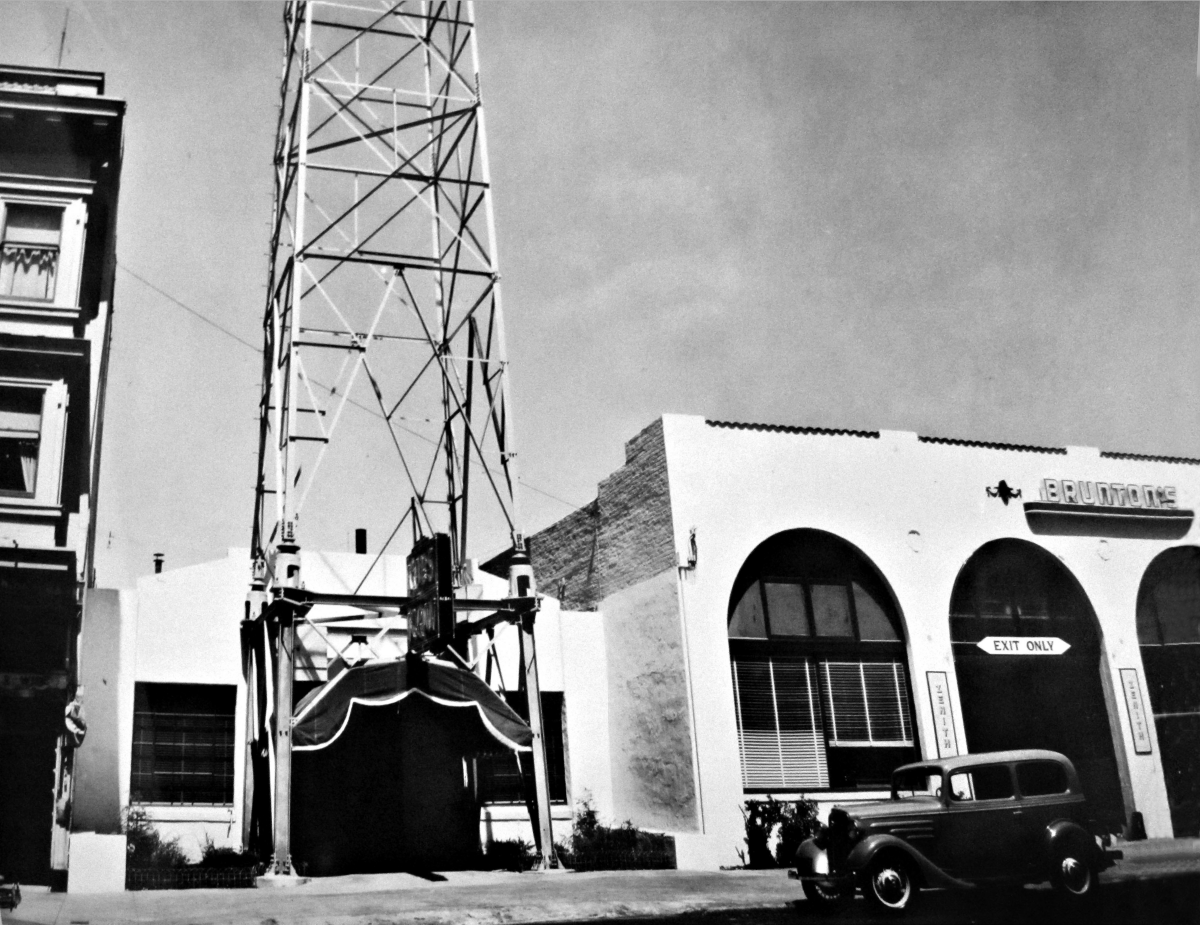
Although the station’s power remained at 500 watts, the effective listening area was increased greatly through the more efficient antenna system. San Francisco listeners found the station’s signal of the first magnitude, while the surrounding communities reported a stronger signal with no fading.
The spectacular antenna in the virtual center of the city has become a landmark, attracting wide comment. The top 100-feet are illuminated by red neon-light strips, making it visible for miles.
KJBS MARCHES ON
And so we find that since its inception in 1925, KJBS has continuously kept pace with the rapid advance of the broadcasting art. It has likewise forged steadily to the fore in popularity with San Francisco and East Bay radio audiences. Today it stands as a power in the broadcasting industry — and an enigma to the higher-powered stations with more elaborate, but not more efficient, equipment.
What is the answer to the remarkable degree of success this radio station has attained from the most humble of beginnings? The answer is a simple one: KJBS has manifested a sincere and earnest desire to present to its listeners the things that they want to hear — in the way they want to hear them.
RELATED EXHIBITS:
![]()

I am researching a former member of the KJBS staff. Found his obituary as follows
Edwin Franklin, 63
S.F. Radio Man
Edwin P. Franklin , longtime Bay Area radio figure, died at his home in Fairfax Saturday after a brief illness. He was 63
A native of Hamburg, Iowa, Mr. Franklin had been active in radio work for about 40 years. He began as a part-time announcer, pioneered an all-music format, and at the time of his retirement some 10 years ago was manager and part-owner of radio station KJBS. The station has since changed its call letters to KFAX.
Survivors include his wife, Betty, two brothers, Benjamin G. Franklin Jr. of Chico and John J. Franklin of East Wareham, Mass. Private funeral services were held Saturday.
(Published San Francisco Examiner, 6 Dec 1971 Page 53)
His death occurred 4 Dec 1971
There was no mention of him as a “part owner” in the history of KJBS.
Mary, I have seen the name “E.P. Franklin” on various KJBS-related items over the years. I don’t have access to all of my station history files right now, but I’ll have a look as soon as I can dig them out. I also note that the FCC doesn’t have “history cards” for KJBS/KFAX on their website yet; they would be an excellent reference for this info.
DJ